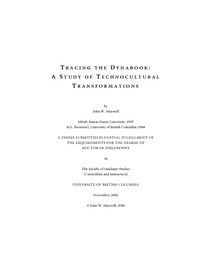 Zusammenfassungen
Zusammenfassungen
 The origins of the personal computer are found in an educational vision. Desktop computing
and multimedia were not first conceived as tools for office workers or media professionals—
they were prototyped as “personal dynamic media” for children. Alan Kay, then at Xerox’ Palo
Alto Research Center, saw in the emerging digital world the possibility of a communications
revolution and argued that this revolution should be in the hands of children. Focusing on the
development of the “Dynabook,” Kay’s research group established a wide-ranging conception of
personal and educational computing, based on the ideal of a new systems literacy, of which
computing is an integral part.
The origins of the personal computer are found in an educational vision. Desktop computing
and multimedia were not first conceived as tools for office workers or media professionals—
they were prototyped as “personal dynamic media” for children. Alan Kay, then at Xerox’ Palo
Alto Research Center, saw in the emerging digital world the possibility of a communications
revolution and argued that this revolution should be in the hands of children. Focusing on the
development of the “Dynabook,” Kay’s research group established a wide-ranging conception of
personal and educational computing, based on the ideal of a new systems literacy, of which
computing is an integral part.Kay’s research led to two dominant computing paradigms: the graphical user interface for personal computers, and object-oriented programming. By contrast, Kay’s educational vision has been largely forgotten, overwhelmed by the sheer volume of discourse on e-learning and the Web. However, an historical analysis of Kay’s educational project and its many contributions reveals a conception of educational computing that is in many ways more compelling than anything we have today, as it is based on a solid foundation of educational theory, one that substantially anticipates and addresses some of the biggest civil/political issues of our time, those of the openness and ownership of cultural expression. The Dynabook is a candidate for what 21st-century literacy might look like in a liberal, individualist, decentralized, and democratic key.
This dissertation is a historical treatment of the Dynabook vision and its implementations in changing contexts over 35 years. It is an attempt to trace the development of a technocultural artifact: the Dynabook, itself partly an idealized vision and partly a series of actual technologies. It is thus a work of cultural history. But it is more than simply a looking back; the effectivehistory of the Dynabook, its various incarnations, and its continuing re-emergence and re-articulation mean that the relevance of this story is an ongoing question which needs to be recognized and addressed by educators, technologists, and learners today. This dissertation represents an introduction to this case.
 Diese Doktorarbeit erwähnt ...
Diese Doktorarbeit erwähnt ...
 Personen KB IB clear | Christopher Alexander , B.J. Allen-Conn , Kent Beck , Amy Bruckman , Jerome S. Bruner , Leo Burd , Michel Callon , Larry Cuban , Allen Cypher , John Dewey , Edsger W. Dijkstra , Andrea diSessa , Fernando Flores , Adele Goldberg , Mark Guzdial , Donna Haraway , Idit Harel , Sara Ishikawa , Yasmin B. Kafai , Alan Kay , Caitlin Kelleher , Thomas S. Kuhn , Bruno Latour , Brenda Laurel , Jean Lave , John Law , Lawrence Lessig , John Maloney , Marshall McLuhan , Nick Montfort , Walter Ong , Seymour Papert , Randy Pausch , Neil Postman , Mitchel Resnick , Kimberly M. Rose , Natalie Rusk , Brian Silverman , Murray Silverstein , Cynthia Solomon , Neal Stephenson , Sherry Turkle , Lew Semjonowitsch Vygotsky , Noah Wardrip-Fruin , Joseph Weizenbaum , Etienne Wenger , Terry Winograd , Stephen Wolfram , Steve Woolgar | ||||||||||||||||||||||||||||||||||||||||||||||||||||||||||||||||||||||||||||||||||||||||||||||||||||||||||||||||||||||||||||||||||||||||||||||||||||||||||||||||||||||||||||||||||||||||||||||||||||||||||||||||||||||||||||||||||||||||||||||||||||||||||||||||||||||||||||||||||||||||||||||||||||||||||||||||||||||||||||||||||||||||||||||||||||||||||||||||||||||||||||||||||||||||||||||||||||||||||||
 Begriffe KB IB clear | AgentSheets
,  Computer Computer computer
, DynabookDynabook
, computer
, DynabookDynabook
,  E-Learning E-Learning E-Learning
, microworldmicroworld
, E-Learning
, microworldmicroworld
,  Multimedia Multimedia multimedia
, programming by demonstrationprogramming by demonstration
, Smalltalk
, multimedia
, programming by demonstrationprogramming by demonstration
, Smalltalk
,  Squeak
, Squeak
,  turtle graphics turtle graphics
| ||||||||||||||||||||||||||||||||||||||||||||||||||||||||||||||||||||||||||||||||||||||||||||||||||||||||||||||||||||||||||||||||||||||||||||||||||||||||||||||||||||||||||||||||||||||||||||||||||||||||||||||||||||||||||||||||||||||||||||||||||||||||||||||||||||||||||||||||||||||||||||||||||||||||||||||||||||||||||||||||||||||||||||||||||||||||||||||||||||||||||||||||||||||||||||||||||||||||||||
 Bücher |
| ||||||||||||||||||||||||||||||||||||||||||||||||||||||||||||||||||||||||||||||||||||||||||||||||||||||||||||||||||||||||||||||||||||||||||||||||||||||||||||||||||||||||||||||||||||||||||||||||||||||||||||||||||||||||||||||||||||||||||||||||||||||||||||||||||||||||||||||||||||||||||||||||||||||||||||||||||||||||||||||||||||||||||||||||||||||||||||||||||||||||||||||||||||||||||||||||||||||||||||
 Texte |
|
 Diese Doktorarbeit erwähnt vermutlich nicht ...
Diese Doktorarbeit erwähnt vermutlich nicht ... 
 Nicht erwähnte Begriffe | AgentCubes |
 Tagcloud
Tagcloud
 Zitationsgraph
Zitationsgraph
 Zitationsgraph (Beta-Test mit vis.js)
Zitationsgraph (Beta-Test mit vis.js)
 Zeitleiste
Zeitleiste
 1 Erwähnungen
1 Erwähnungen 
- Digital lesen - Wandel und Kontinuität einer literarischen Praktik (Franziska Wilke) (2022)


 Volltext dieses Dokuments
Volltext dieses Dokuments
 |  Tracing the Dynabook: Gesamtes Buch als Volltext ( Tracing the Dynabook: Gesamtes Buch als Volltext ( : :  , 1673 kByte; , 1673 kByte;  : :  Link unterbrochen? Letzte Überprüfung: 2021-03-21 Letzte erfolgreiche Überprüfung: 2016-01-11) Link unterbrochen? Letzte Überprüfung: 2021-03-21 Letzte erfolgreiche Überprüfung: 2016-01-11) |
 Anderswo suchen
Anderswo suchen 
 Beat und diese Dissertation
Beat und diese Dissertation
Beat hat diese Dissertation während seiner Zeit am Institut für Medien und Schule (IMS) ins Biblionetz aufgenommen. Beat besitzt kein physisches, aber ein digitales Exemplar. Eine digitale Version ist auf dem Internet verfügbar (s.o.). Es gibt bisher nur wenige Objekte im Biblionetz, die dieses Werk zitieren.









 (
( Biblionetz-History
Biblionetz-History